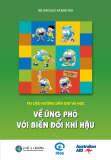
1
THAI NGUYEN UNIVERSITY OF AGRICULTURE AND FORESTRY
INTERNATIONAL PROGRAM OFFICE
ESP 123
INTRODUCTION TO FIELD AND LABORATORY
METHODS IN ECOLOGY
Syllabus

2
Teaching Staff
Subject lecturer: NGUYEN THI THU HUONG
Organization:
Office Location:
Phone:
Mobile phone: 0912 530872
Email: nguyenhuong0987@gmail.com
Consultation hours: 45
Msc. Nguyen Thi Thu Huong obtained her Bsc (Honors) in Biological Science and Msc in
Ecology and Environmental Science from Hanoi national University of Education. Her
second Msc is Animal Science conferred by the University of Queensland Australia.
Subject Overview
Welcome to ESP 123, this course provides you the tools to study principles of ecology and
other related fields. It develops from the courses of biology, ecology, statistics and research
methodology. In this course we will examine the whole process of conducting a general
ecological study of which focus on methodologies to collect and analyses data. Topic includes
a general design of an ecological study, sampling methodologies, ecological measurements,
analysis of habitat, population and production, interpreting information by using statistic
software and presenting research information.
Learning Outcomes
This course aims to provide student tools to conduct general ecological researches both in the
field and laboratory. After successfully completing this course you should be able to:
1. Demonstrate understanding of procedure for planning an ecological research project.
2. Describe project design and data management in field research.
3. Understand how to choose and describe the research sites.
4. Describe general sampling techniques for static and mobile organisms.
5. List and describe the measurements and methodologies for analysing habitat, populations,
community and production.
6. Develop ability to collect, analyse and organise information from theory to practice.
7. Strengthen ability to interact effectively with others in order to work towards a common
outcome.
8. Reinforce ability to work and learn independently.

3
Subject Structure
Students are expected to attend [how many] lectures.
The Subject’s timetable is as follows:
Lecture time and location:
[lecture time] [location]
List of lectures
Lecture No.
Topic
Instructional delivery
methods
PART 1. PREPARATION
1-2
1.1. Choosing a topic for study
Narrate, questioning
3
1.2. Literature review
4-5
1.3. Experimental design
Practice a case study
6
1.4. Practical considerations
Lecture
1.5. Sampling methods
Presentation
PART 2. DATA COLLECTION
Demonstration
2.1. Monitoring research site
7
2.1.1. Site selection
Lecture
2.2.2. Site characterisation
Presentation
2.2. Sampling static organisms
8
2.2.1. Ecological measurements
Lecture
9
2.2.2. Plot sampling
Lecture,
demonstration, group
discussion
10
2.2.3. Transect sampling
11-12
2.2.4. Quadrat sampling
2.3. Sampling mobile organisms
13-15
2.3.1. General issues
Questioning
2.3.2. Terrestrial invertebrate sampling
Lecture, virtual
demonstration
16-17
2.3.3. Aquatic sampling
Presentation, case
study
18
2.3.4. Capture – recapture sampling
Filling in game
19
2.3.5. Removal sampling
20-28
2.3.6. Terrestrial vertebrate sampling
Lecture, virtual
demonstration
MIDTERM EXAM
PART 3. ANALYSING INFORMATION
3.1. Analysis of habitat
29
3.1.1. Microhabitat analysis
Lecture, pair-up
interview
3.1.2. Atmospheric analysis
30
3.1.3. Substrate analysis
Discussion
31
3.1.4. Analysis of aquatic habitats
Lecture
3.1.5. Chemical analysis of habitats
Discussion,

4
presentation
32
3.1.6. Habitat assessment
Lecture
Virtual labs exercise
3.2. Analysis of population
33
3.2.1. Age structure and survivorship
Lecture, in class
exercise
3.2.2. Population growth
34
3.2.3. Population desperation
Presentation
3.2.4. Competition
Lecture , Self-study
3.2.5. Predator
3.3. Analysis of community
Presentation
35
3.3.1. Community structure
Questioning
3.3.2. Species diversity
Group discussion
3.3.3. Community similarity
Take home exercise
36
3.3.4. Ecological succession
Lecture
Virtual labs exercise
3.4. Analysis of production
37
3.4.1. Biomass measurement
Lecture
3.4.2. Aquatic productivity
Presentation
38
3.4.3. Aquatic micro ecosystem
Group discussion
39-40
3.5. Testing the hypothesis using basic statistical
test and simple linear models
Practicing Minitab
software
PART 4. PRESENTING INFORMATION
41
4.1.Structure
Questioning
42
4.2. Writing style
Case study
43-45
PRESENTATION
Reading materials:
Required resource
1. Brower, J. E., Zar, J. H., & Von Ende, C. N. (1998), ‘Field and laboratory methods for
general ecology’, 4 edition, McGraw-Hill Education.
2. Wajnberg E; Bernstein Carlos; Alphen Jacques van (2007). Behavioral ecology of insect
parasitoids from theoretical approaches to field applications
3. Suitability of north american tree species to the gypsy moth: a summary of field and
laboratory tests (1995). Liebhold, Andrew M ; Northeastern Forest Experiment Station
(Radnor, Pa.)
4. New Paleobiology Study Findings Have Been Reported by Investigators at Trinity
College (Predation on feather stars by regular echinoids as evidenced by laboratory and
field observations and its paleobiological implications). Science Letter, (2017_, p.1052
Other learning resource and information:
Please check the website where you can conduct some virtual labs
http://glencoe.mheducation.com/sites/0078695104/student_view0/unit1/chapter4/index.html

5
Attendance/ Participation Requirements
Lecture Attendance Requirement:
Attendance at all lectures is expected. If, for whatever reason, you cannot attend the lecture,
please let the lecturer know in advance. You are required to attend a minimum of 75% of
lectures.
Assessment
Assessment for this subject consists of :
Assessment task
Weighting
Due date
Presentation
20%
Midterm exam
30%
Final exam
50%
Assessment Criteria:
Assignment
Type: Assignment
Learning Objectives Assessed: 1, 2, 3, 4, 5, 7.
Due date:
Weight: 20%
Task Description: Design an experiment that related to ecological sciences. The study can
be a real or an artificial case/problem/issue that consist data collection in the field and analysis
in the laboratory. The presentation should include the research question, hypothesis,
objectives and methods. The methodology have to be described in details.
You will conduct this assignment by group of 5 students. The group is assigned randomly
from the name list. Each group registers their study topic in the fourth lecture. The
experimental design will be presented in the three last sessions. Each presentation lasts in 8
mins (5 mins for presenting and 3 mins for questioning).
Peer marking is applied in the presentation and worth 70%. The remaining (30%) is lecturer’s
assessment.
Midterm exam
Type: Exam - during Exam Period (Middle)
Learning Objectives Assessed: 1, 2, 3, 4, 5, 6
Due Date: Examination Period
Weight: 30%
Reading: 10 minutes
Duration: 60 minutes




![Câu hỏi ôn tập Môi trường và phát triển [năm]](https://cdn.tailieu.vn/images/document/thumbnail/2025/20250710/kimphuong1001/135x160/2361752136158.jpg)
![Câu hỏi ôn tập Con người và môi trường: Tổng hợp [mới nhất/chuẩn nhất]](https://cdn.tailieu.vn/images/document/thumbnail/2025/20250704/kimphuong1001/135x160/8741751592841.jpg)
![Câu hỏi ôn tập môn Môi trường [chuẩn nhất]](https://cdn.tailieu.vn/images/document/thumbnail/2025/20250702/kimphuong555/135x160/62401751441591.jpg)
![Tài liệu tập huấn quản lý và bảo tồn đất ngập nước [mới nhất]](https://cdn.tailieu.vn/images/document/thumbnail/2025/20250627/vijiraiya/135x160/30351751010876.jpg)



![Bài tập Thiên tai và Biến đổi Khí hậu: Tổng hợp [chuẩn nhất/mới nhất]](https://cdn.tailieu.vn/images/document/thumbnail/2025/20251208/thanhminh1107/135x160/77331765248072.jpg)

![Tài liệu Vi sinh vật môi trường [Mới nhất]](https://cdn.tailieu.vn/images/document/thumbnail/2025/20251123/ngkimxuyen/135x160/21891763953413.jpg)
![Sổ tay truyền thông Phân loại chất thải rắn sinh hoạt trên địa bàn tỉnh Quảng Nam [Chuẩn nhất]](https://cdn.tailieu.vn/images/document/thumbnail/2025/20251114/kimphuong1001/135x160/1701763094001.jpg)


![Quản lý chất thải nguy hại: Sổ tay Môi trường [Chuẩn nhất]](https://cdn.tailieu.vn/images/document/thumbnail/2025/20251029/kimphuong1001/135x160/9011761720170.jpg)








